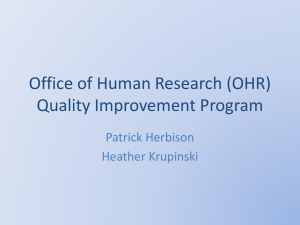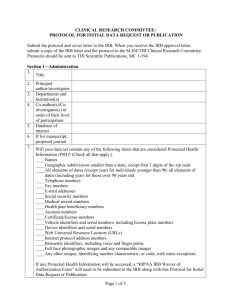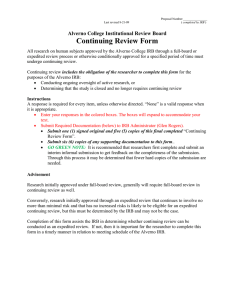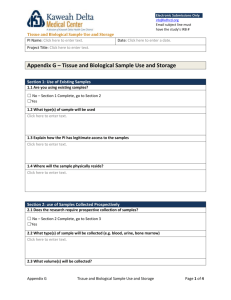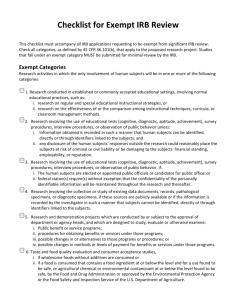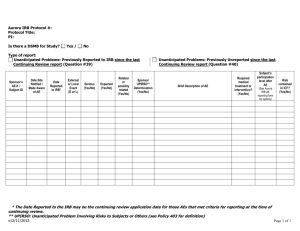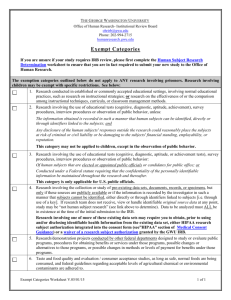IRB Study Closure I. Applicant Status And Contact Information
advertisement
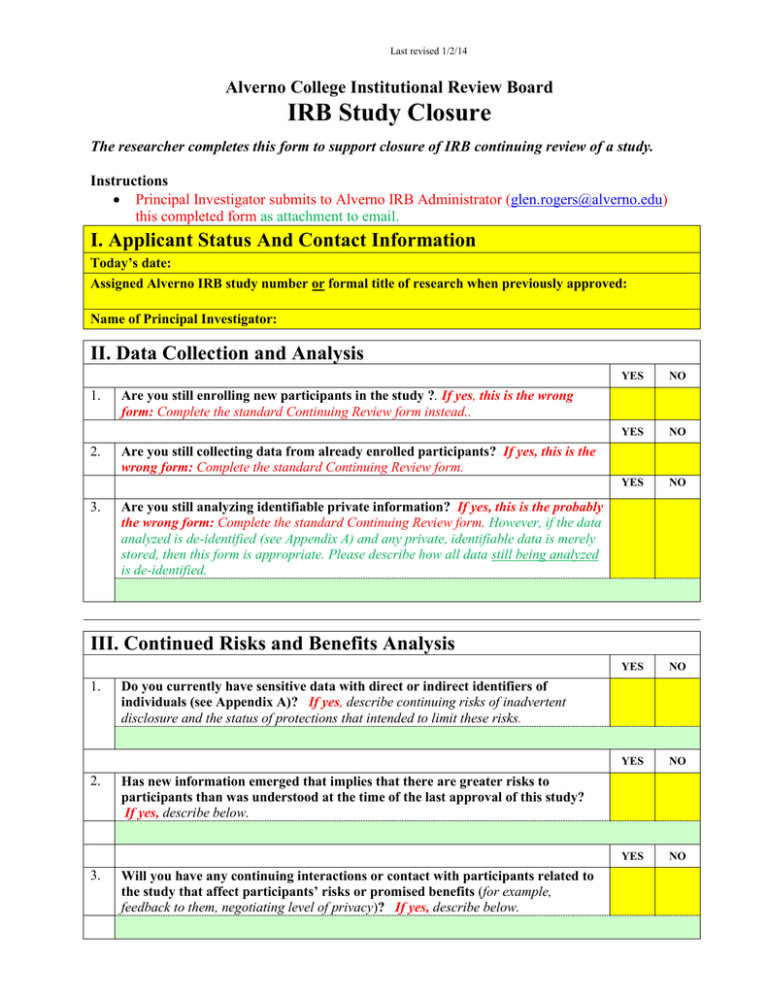
Last revised 1/2/14 Alverno College Institutional Review Board IRB Study Closure The researcher completes this form to support closure of IRB continuing review of a study. Instructions Principal Investigator submits to Alverno IRB Administrator (glen.rogers@alverno.edu) this completed form as attachment to email. I. Applicant Status And Contact Information Today’s date: Assigned Alverno IRB study number or formal title of research when previously approved: Name of Principal Investigator: II. Data Collection and Analysis 1. 2. 3. YES NO YES NO YES NO YES NO YES NO YES NO Are you still enrolling new participants in the study ?. If yes, this is the wrong form: Complete the standard Continuing Review form instead.. Are you still collecting data from already enrolled participants? If yes, this is the wrong form: Complete the standard Continuing Review form. Are you still analyzing identifiable private information? If yes, this is the probably the wrong form: Complete the standard Continuing Review form. However, if the data analyzed is de-identified (see Appendix A) and any private, identifiable data is merely stored, then this form is appropriate. Please describe how all data still being analyzed is de-identified. III. Continued Risks and Benefits Analysis 1. 2. 3. Do you currently have sensitive data with direct or indirect identifiers of individuals (see Appendix A)? If yes, describe continuing risks of inadvertent disclosure and the status of protections that intended to limit these risks. Has new information emerged that implies that there are greater risks to participants than was understood at the time of the last approval of this study? If yes, describe below. Will you have any continuing interactions or contact with participants related to the study that affect participants’ risks or promised benefits (for example, feedback to them, negotiating level of privacy)? If yes, describe below. Continuing Review Form Page 2 Appendix A: Alverno IRB De-Identification Standard for Information Protecting the privacy of research participants is a general concern in the vast majority of research projects. Privacy refers to an individual’s control over the extent, timing, and circumstances of sharing of his or herself. The level of measures needed to ensure the participant’s right to privacy depends on the nature of the particular research, its setting, and the research participants. For especially sensitive data it may be most appropriate for the researcher to ensure anonymity, where no one—including the researcher—is ever able to link the participant with his or her responses. In other instances, researchers have a general obligation to reduce the risks of unintended disclosure of collected information about individual research participants. The researcher should consider the following de-identification question when collecting and handling sensitive data. Does the information I am accessing, recording, and/or disclosing contain identifiers? Simple access to information may be without concern, for example when the researcher is an employee who routinely handles the records in carrying out his or her position. But, the presence of identifiers in any recorded (or disclosed by researcher) information means this information does not meet the Alverno IRB standard for a de-indentified data set and may require extra safe guards that would be appropriate to the sensitivity of the data. The Alverno IRB de-identification standard includes all 18 direct identifiers specified in the HIPAA Privacy Rule—45 CFR 164.514(b). Below are listed, in condensed format, specific direct and indirect identifiers related to de-identification of a data set. These standards are printed here to assist the researcher in communicating with the IRB about provisions for preventing inadvertent disclosure of collected data. Identifiers: Direct; Indirect One way to distinguish between truly de-indentified information recorded in a data set from information in a data set that is being kept confidential by other means is to determine if the data set contains direct or indirect identifiers. Information in a data set with either direct or indirect identifiers is not de-identified. Direct Identifiers include: Names Addresses Telephone and fax numbers Email addresses, IP addresses, and URLs Social Security numbers Medical record numbers Account numbers, such as those associated with bank accounts or health plans License or certificate numbers, including driver's license numbers License plate numbers and other vehicle identifiers Fingerprints, voiceprints, or full-face photographic images Other unique characteristics or identification numbers (example student ID numbers) Indirect Identifiers can be combined with publicly available information to identify individuals. The determination of indirect identifiers depends on the nature of the research participants. For example, in a study of residents of the state of Wisconsin, the information that someone graduated from one of the UW system schools probably would not be a unique identifier. However, in a study of small business leaders in Ithaca, New York, the same information might well apply to only one individual. In general, if any single variable in a data set applies to fewer than five participants, it is considered a potential indirect identifier. Examples of indirect identifiers include: Detailed geographical information, such as state, county, or census tract of residence Organizations to which participants belong Educational institutions from which participants graduated Exact occupations Places where participants grew up Many dates, including birth dates, hospital admission dates, high school or college graduation dates, etc. Detailed income information Offices or posts held by participants
